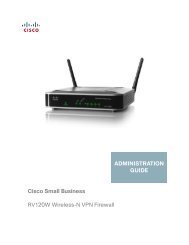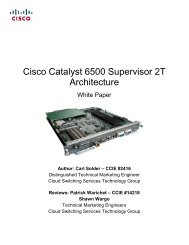Cisco WAP200 Wireless-G Access Point with PoE and ...
Cisco WAP200 Wireless-G Access Point with PoE and ...
Cisco WAP200 Wireless-G Access Point with PoE and ...
You also want an ePaper? Increase the reach of your titles
YUMPU automatically turns print PDFs into web optimized ePapers that Google loves.
<strong>Wireless</strong>-G <strong>Access</strong> <strong>Point</strong> <strong>with</strong> Power Over Ethernet <strong>and</strong> RangeboosterWhat IEEE 802.11g features are supported?The product supports the following IEEE 802.11g functions:• CSMA/CA plus Acknowledge protocol• OFDM protocol• Multi-Channel Roaming• Automatic Rate Selection• RTS/CTS feature• Fragmentation• Power ManagementWhat is Ad-hoc?An Ad-hoc wireless LAN is a group of computers, each <strong>with</strong> a WLAN adapter, connected as an independentwireless LAN. An Ad-hoc wireless LAN is applicable at a departmental scale for a branch or SOHO operation.What is Infrastructure?An integrated wireless <strong>and</strong> wired LAN is called an Infrastructure configuration. Infrastructure is applicable toenterprise scale for wireless access to a central database, or wireless application for mobile workers.What is roaming?Roaming is the ability of a portable computer user to communicate continuously while moving freely throughoutan area greater than that covered by a single <strong>Access</strong> <strong>Point</strong>. Before using the roaming function, the workstationmust make sure that it is set to the same channel number as the <strong>Access</strong> <strong>Point</strong> of the dedicated coverage area.To achieve true seamless connectivity, the wireless LAN must incorporate a number of different functions. Eachnode <strong>and</strong> <strong>Access</strong> <strong>Point</strong>, for example, must always acknowledge receipt of each message. Each node mustmaintain contact <strong>with</strong> the wireless network even when not actually transmitting data. Achieving these functionssimultaneously requires a dynamic RF networking technology that links <strong>Access</strong> <strong>Point</strong>s <strong>and</strong> nodes. In such asystem, the user’s end node undertakes a search for the best possible access to the system. First, it evaluatessuch factors as signal strength <strong>and</strong> quality, as well as the message load currently being carried by each <strong>Access</strong><strong>Point</strong> <strong>and</strong> the distance of each <strong>Access</strong> <strong>Point</strong> to the wired backbone. Based on that information, the node nextselects the right <strong>Access</strong> <strong>Point</strong> <strong>and</strong> registers its address. Communications between end node <strong>and</strong> host computercan then be transmitted up <strong>and</strong> down the backbone.As the user moves on, the end node’s RF transmitter regularly checks the system to determine whether it is intouch <strong>with</strong> the original <strong>Access</strong> <strong>Point</strong> or whether it should seek a new one. When a node no longer receivesacknowledgment from its original <strong>Access</strong> <strong>Point</strong>, it undertakes a new search. Upon finding a new <strong>Access</strong> <strong>Point</strong>, itthen re-registers, <strong>and</strong> the communication process continues.Appendix A: TroubleshootingFrequently Asked Questions44
















